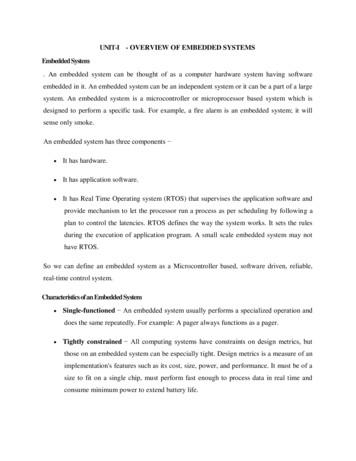Embedded System And Real-time Lecture 3
Tishk International University Engineering Faculty Mechatronics Engineering Department Lecture 3: 17/10/2022 Embedded System and Real-time Lecture 3 Instructor: Dr. Rand Basil Alhashimie 1
Outline Multilevel PLA/PAL GAL, CPLD An Embedded System Designer’s View An Embedded System from Customer View An Embedded System from World View 2
MULTI-LEVEL DESIGN USING REGISTERED PAL/PLA 3
Difference between PAL and PLA 4
GENERIC PAL (GAL) 5
GENERIC PAL (GAL) 6
2. COMPLEX PROGRAMMABLE LOGIC DEVICES (CPLDS) SPLDs (PLA, PAL) are limited in size due to the small number of input and output pins and the limited number of product terms Combined number of inputs outputs 32 or so CPLDs contain multiple circuit blocks on a single chip Each block is like a PAL: PAL-like block Connections are provided between PAL-like blocks via an interconnection network that is programmable Each block is connected to an I/O block as well 7
COMPLEX PROGRAMMABLE LOGIC DEVICES (CPLDS) Structure of CPLD 8
COMPLEX PROGRAMMABLE LOGIC DEVICES (CPLDS) Structure of CPLD 9
COMPLEX PROGRAMMABLE LOGIC DEVICES (CPLDS) 10
CPLD Implementation 11
3. Field Programmable Gate Array (FPGA) Field Programmable Gate Array (FPGA) devices were introduced by Xilinx in the mid 1980s. They differ from CPLDs in architecture, storage technology, number of built-in features, and cost, and are aimed at the implementation of high performance, large-size circuits. Field Programmable Gate Arrays (FPGA) can handle larger circuits No AND/OR planes Provide logic blocks, I/O blocks, and interconnection wires and switches 12
PROGRAMMING SPLDS/CPLDS PLAs, PALs, and ROMs are also called SPLDs – Simple Programmable Logic Devices SPLDs must be programmed so that the switches are in the correct places There are two basic types of programming techniques Removable sockets on a PCB In system programming (ISP) on a PCB This approach is not very common for PLAs and PALs but it is quite common for more complex PLDs 13
PROGRAMMING SPLDS/CPLDS Removable sockets on a PCB The SPLD/CPLD is removed from the PCB, placed into the unit and programmed there 14
PROGRAMMING SPLDS/CPLDS In System Programming (ISP) Used when the SPLD/CPLD cannot be removed from the PCB. A special cable and PCB connection are required to program the SPLD from an attached computer. Very common approach to programming more complex PLDs like CPLDs, FPGAs, etc. 15
An Embedded System Design – Designer’s View Measured by: Cost, I/O Connections, Memory size, Function, Performance. 16
An Embedded System Design – Customer’s View Reduced Cost Increased Functionality Improved Performance Increased Overall Dependability 17
An Embedded System Design –World View A complex set of tradeoffs: Optimize for more than just speed Consider more than just the computer Take into account more than just initial product design 18
Embedded System Categories Four General Categories of Embedded Systems General Computing Applications similar to desktop computing, but in an embedded package Video games, set-top boxes, wearable computers, automatic tellers Tablets, Phablets Control Systems Closed loop feedback control of real time system Vehicle engines, chemical processes, nuclear power, flight control 19
Embedded System Categories Signal Processing Computations involving large data streams Radar, Sonar, video compression Communication & Networking Switching and information transmission Telephone system, Internet Wireless everything 20
Next Lecture Real-time System FPGA 21
Embedded System Categories Four General Categories of Embedded Systems General Computing Applications similar to desktop computing, but in an embedded package Video games, set-top boxes, wearable computers, automatic tellers Tablets, Phablets Control Systems Closed loop feedback control of real time system
2. Embedded systems Vs General Computing system Page 4 Sec 1.2 ; 3. History of embedded systems , classification of embedded system Page 5,6 Sec 1.3 , Sec 1,4 . 4. Major application area of embedded sys Page 7 Sec 1.5 5. Purpose of embeded system Page 8 Sec 1.6 6. Typical Embedded sys: Core of embedded system Page 15 Chap 2 : 7. Memory Page 28
Real-Time Operating Systems are often used in embedded systems They simplify use of hardware, ease management of multiple tasks, and adhere to real-time constraints Power is important in many embedded systems with RTOSs . Specialized or static memory management common 14 Robert Dick Embedded System Design and Synthesis
players, digital cameras, video game consoles, microwave ovens and temperature measurement systems. Real Time Embedded Systems A real time embedded system is defined as, a system which gives a required o/p in a particular time.These types of embedded systems
The network embedded system is a fast growing area in an embedded system application. The embedded web server is such a system where all embedded device are connected to a web server and can be accessed and controlled by any web browser. Examples; a home security system is an example of a LAN networked embedded system .
26 Robert Dick Embedded System Design and Synthesis Reliable embedded system design and synthesis Scheduling Overview of real-time and embedded operating systems Embedded application/OS time, power, and energy estimation Homework Algorithm correctness Appropriate responses to transient faults Appropriate responses to permanent faults
1.1 Hard Real Time vs. Soft Real Time Hard real time systems and soft real time systems are both used in industry for different tasks [15]. The primary difference between hard real time systems and soft real time systems is that their consequences of missing a deadline dif-fer from each other. For instance, performance (e.g. stability) of a hard real time system such as an avionic control .
6 Real Time Constraints Many Embedded Systems must meet real-time constraints zA real-time system must react to stimuli from the controlled object (or the operator) within the time interval dictated by the environment. zFor real-time systems, right answers arriving too late are wrong. Frequently connected to physical environment through sensors and actuators.
2) K.V.K.K.Prasad, “Embedded Real-Time Systems: Concepts, Design & Programming”, dreamtech press, 2005. 3) Tim Wilmshurst, “An Introduction to the Design of Small Scale Embedded Systems”, Pal grave Publisher, 2004. 4) Sriram V Iyer, Pankaj Gupta, “Embedded Real Time Systems Programming”, Tata Mc-Graw Hill, 2004.























